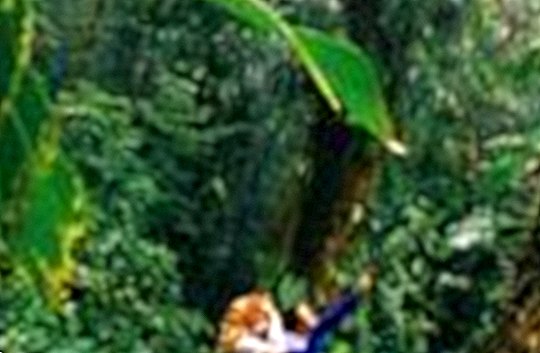Ecotourism: In the jungles of Costa Rica

"Wait," Simon whispers, stopping us with a conspiratorial gesture, "wait until the tractor is gone." Slowly the motorbump blurs in the dark green of the forest. "Now listen to this strange world." There we are - John and Pam from New York, Maduka from Tokyo, Roman and myself from Hamburg - and listening to the dripping and the flutes, the rustling and whispering of the tropical rainforest. That's the sound of Rara Avis, a private reserve in Costa Rica.
Anyone who goes on vacation here will not only gain new experiences with all their senses, but also contribute to the preservation of this strange world. The proceeds will be used to finance reforestation, research projects and scientific staff. It is not easy to come here. We were shaken in the back of a trailer while a small tractor pulled our vehicle across a muddy path. The tractor from the village of Las Horquetas normally takes three hours to reach the "Waterfall Lodge". For 15 kilometers. If it does not rain and the tractor holds out.
This hotel transfer has hardships. But you know that before and pay anyway. Rara Avis is not for people who just time check off a sightseeing tour in the rain forest and whine over wet feet afterwards. If you visit this project, you should bring a few days time and get a pair of rubber boots at the latest in Las Horquetas.

The ground is soft and deep. He exudes the heavy rottenness of particular fertility. In single file we dart through the velvety wilderness, sinking to our knees in the mud, slipping over roots. My rubber boots are already skidding across the floor. I reach for a liana, think briefly of Simon's words: The Canadian biologist had warned us to look carefully what we want to hold on to. "Every branch could be a snake." Thankfully, this lankan, which is rich in arm, is truly a liana. The path snakes its way through tree giants, past aerial roots and palm trees. Orchids, ivy and ferns proliferate on the mighty trunks. A colorful, wasteful over and under, in which nothing happens to grow and everything strives for the light.
Costa Rica - a small, peaceful country in Central America often called the "green paradise". Not wrong. With an area of approximately 51,000 square kilometers, Costa Rica is one of the dwarf states of the world, but in terms of biodiversity, the tiny country is a giant on the blue planet - with five percent of all world-wide plant and animal species, of which more than one District is under protection. As in a huge open-air eco-museum, you can visit all the Central American landscapes in the various national parks: volcanic craters, wetlands, cloud forests.
But outside the protected areas Costa Rica is no longer paradise. More and more banana plantations and cattle grazing displace the rainforest, about 75 percent are already cut down. And despite the now rigid forest laws, conservationists fear even more clear-cutting. The state of Costa Rica lacks the money to identify more reserves. Private initiative is needed. Rara Avis is a role model for that.
The American biologist Amos Bien is the founder of Rara Avis: he bought this piece of rainforest in the heart of Costa Rica, a pristine world in the north of the village Horquetas. It is only a one and a half hour bus ride to San José, the capital of Costa Rica. Civilization and jungle are so close together.
Rain in the rainforest

How much is a forest? About the price is not spoken. For the better of the mission - to protect the forest and to prove that you can earn money with it: 157 orchid species bloom here, some are bred, one can take over sponsorships for the sometimes little known flowers; intended for sale are the seedlings of a rare palm species or the butterfly-sized butterflies whose larvae are exported to US and European botanical gardens.
Above all, the "Waterfall Lodge" is financing the project, a two-storey wooden guest house on a clear hill in the forest: eight rustic rooms, with mosquito nets instead of glass in the window frames; without electricity, but with the light of kerosene lamps, which smoldered a little dull, but so a cozy "oh-the-world-but-good-feeling" exudes. However, there is also comfort in the right place: a private shower in the tiled bathroom. It is almost always wet anyway. Because you're always sweating in the tropical heat or because it's raining again - in the rainforest.
The next morning we do not wake up with the first sunlight, but from the deafening radon of the approximately 360 different species of birds that live here.They deliver the soundtrack to a ten-minute climb to a waterfall thundering into a stone basin. Morning shower. Just dunk and wake up.
Later we are under a jungle giant. Ropes hang down from 30 meters height. We put on hip straps, Simon fixes clamps on the ropes. Meter by meter we pull ourselves up and climb into a tree house. In front of us a piece of the "green paradise". No land in sight. About us only the sky.
Travel Info Costa Rica
Travel time: "Verano", summer, means the time from December to April, it is 25 degrees warm and barely rainy. The rainy year is called "Invierno", winter, broken only by two short fine weather periods in July / August and September / October, the "Veranillo" hot - small summer.
Contact: Booking at the travel agency or directly from Rara Avis, P.O. Box 8105-1000, San José, Costa Rica, Tel. 005 06 / 764-31 31, Fax 764-41 87, www.rara-avis.com










